The pertinence of human activity recognition systems in the present era
In recent years, human activity recognition has gained significant attention inside the scientific community. The enhanced spotlight is on the ground of its direct application in multiple domains. The latest research at the Department of Computer Science validates this assumption. Assistant Professor Dr V M Manikandan, and the 4th year B Tech Student Chaitanya Krishna Pasula have published a chapter titled An analysis of human activity recognition systems and their importance in the current era in the book Computational Intelligence Based Solutions for Vision Systems. The book is published by IOP Publishing Ltd.
Explanation of the chapter
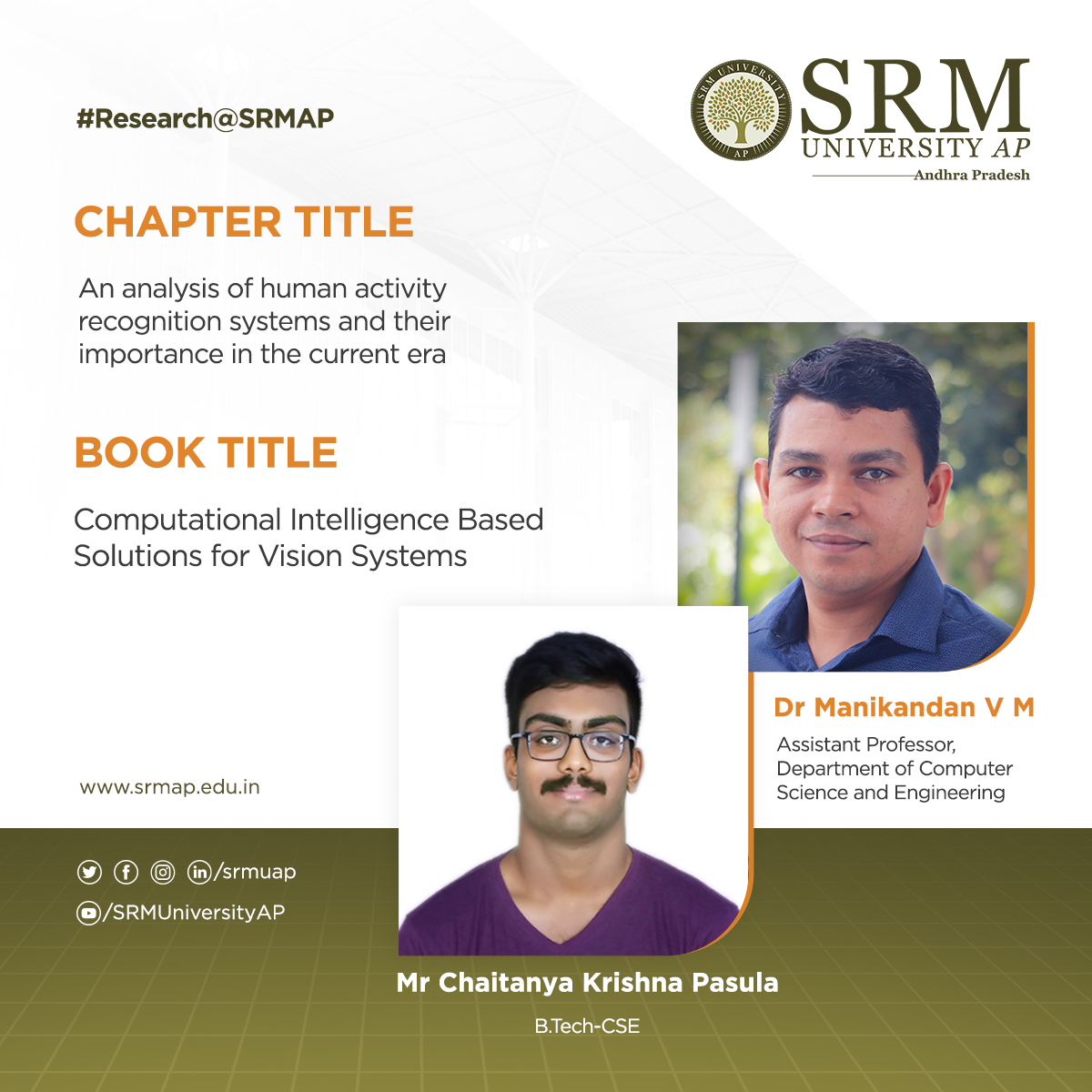 Human activity recognition is one of the most interesting and active research areas in computer vision. More research efforts are being put towards automatically identifying and analysing human activities due to their emerging importance in everyday applications. It serves applications in various areas like security video surveillance, smart homes, healthcare, human-computer interaction, virtual reality, robotics, and digital entertainment. Numerous papers have been published in the domain of human activity recognition. This book chapter discusses the various applications of human activity recognition, different methods available for automatic activity detection from videos, and the advantages of the human activity recognition system. It also describes the challenges in designing and implementing human activity detection schemes. Researchers further explain the publicly available datasets used for training and evaluating the systems for human activity recognition. The efficiency parameters used to evaluate the human activity recognition systems are also briefed in this chapter. The chapter is concluded by comparing the methodologies and speculating the possibilities of future research in this field.
Human activity recognition is one of the most interesting and active research areas in computer vision. More research efforts are being put towards automatically identifying and analysing human activities due to their emerging importance in everyday applications. It serves applications in various areas like security video surveillance, smart homes, healthcare, human-computer interaction, virtual reality, robotics, and digital entertainment. Numerous papers have been published in the domain of human activity recognition. This book chapter discusses the various applications of human activity recognition, different methods available for automatic activity detection from videos, and the advantages of the human activity recognition system. It also describes the challenges in designing and implementing human activity detection schemes. Researchers further explain the publicly available datasets used for training and evaluating the systems for human activity recognition. The efficiency parameters used to evaluate the human activity recognition systems are also briefed in this chapter. The chapter is concluded by comparing the methodologies and speculating the possibilities of future research in this field.
In the future, the researchers are planning to design and implement an activity recognition system to identify abnormal activities in public places for safety purposes. This book chapter will be a helpful reference for UG/PG/Ph.D students who aspire to research in the domain of activity detection from video.
- Published in CSE NEWS, Departmental News, News, Research News
Food safety applications of surface-enhanced Raman Spectroscopy
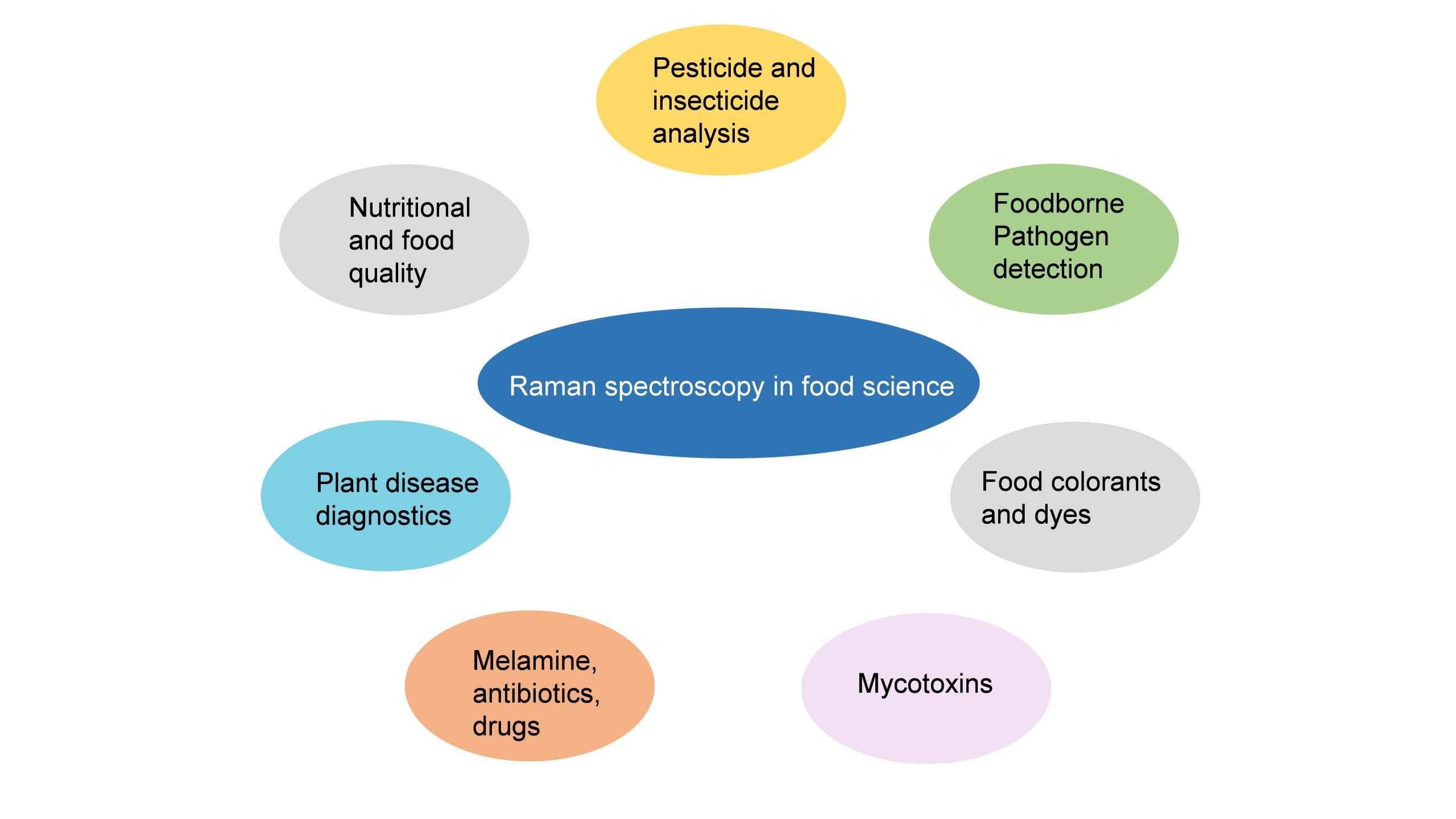
Surface-enhanced Raman Spectroscopy (SERS) is a nuanced chemical technique that amplifies the Raman scattering of molecules by utilising plasmonic nanostructured materials. SERS operates as a powerful detection tool that allows for the structural fingerprinting of a molecule. The ultra-high sensitivity and selectivity of the process offer it a vast array of applications in surface and interface chemistry, nanotechnology, biology, biomedicine, food science, environmental analysis and other areas.
Dr J P Raja Pandiyan and his PhD scholar, Ms Arunima Jinachandran from the Department of Chemistry have been keenly involved in exploring the possibilities of SERS technology in food science and other fields. The safety and quality concerns related to food were the primary reasons that impelled them to step into this domain. Their article “Surface-enhanced Raman spectroscopy for food quality and safety monitoring” was published in the book Nanotechnology Applications for Food Safety and Quality Monitoring, published by Elsevier. The article was published in collaboration with Dr Selvaraju Kanagarajan from the Swedish University of Agricultural Sciences.
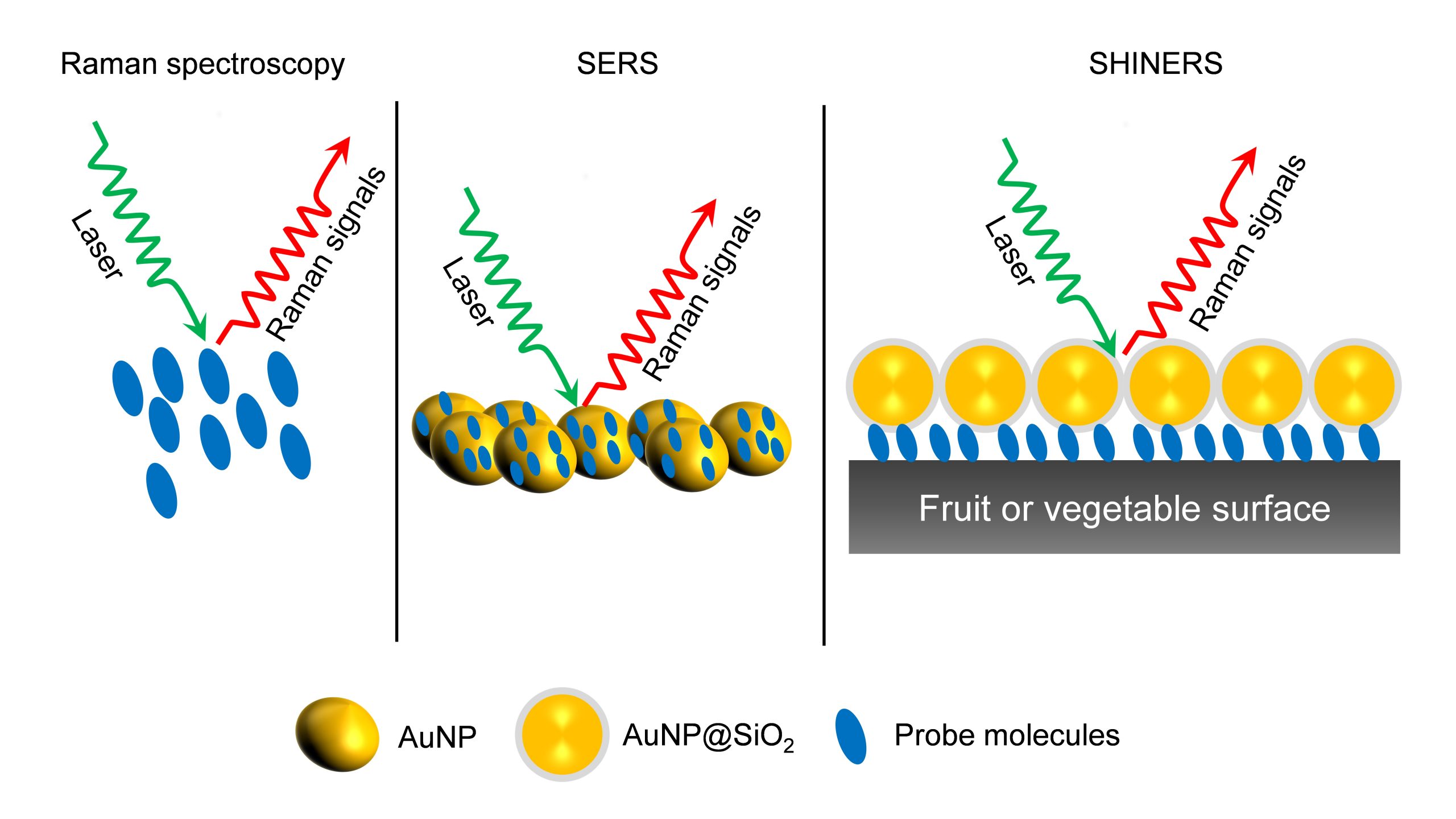 As an analytical technique, SERS possesses several advantages such as non-destructive, sensitive, and selective. In the chapter, the necessity, and applications of SERS in food science are elaborately discussed. They have also discussed all the possible food contaminants and how to identify them using SERS to ensure food quality. This book will serve as an enlightening read to research groups who are working on Raman, surface-enhanced Raman spectroscopy, analytical chemistry, and food quality analysis.
As an analytical technique, SERS possesses several advantages such as non-destructive, sensitive, and selective. In the chapter, the necessity, and applications of SERS in food science are elaborately discussed. They have also discussed all the possible food contaminants and how to identify them using SERS to ensure food quality. This book will serve as an enlightening read to research groups who are working on Raman, surface-enhanced Raman spectroscopy, analytical chemistry, and food quality analysis.
- Published in Chemistry-news, Departmental News, News, Research News
Comparing organic food preferences of American and Indian consumers
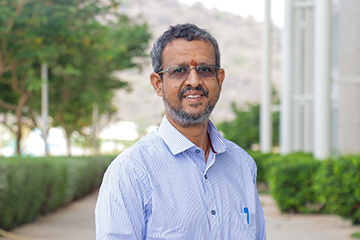
A paper titled “Organic food preferences: A comparison of American and Indian consumers” has been published by Prof Bharadhwaj Sivakumaran, Dean- SEAMS, SRM University-AP, Kirubaharan Boobalan (SSN College of Engineering), and Margaret Susairaj (Great Lakes Institute of Management, Chennai) in the journal Food Quality and Preference having an Impact Factor of 5.6.
This research tests a nomological model predicting organic food attitudes and purchase intentions in USA and India. Data were collected from India (n = 687) and the USA (n = 632) using Amazon M Turk and were analyzed using structural equation modelling and multi-group moderation technique. Results revealed that over and above attitude, subjective norm and perceived behavioural control, response efficacy and self-expressive benefits significantly affect consumers’ attitudes and purchase intentions toward organic food among American and Indian consumers. Findings reveal that response efficacy and attitude matter more in the USA while subjective norms and self-expressive benefits exert a greater influence in India. Therefore, marketers may reinforce belief-related elements while selling organic food products in the USA and societal-related elements while selling in India. Theoretically, this work adds to the Theory of Planned Behavior by adding self-expressive benefits and develops a common model for organic food across samples in USA and India.
- Published in Dean, Departmental News, News, Paari Current Happenings, Research News
Interview mastery for global study opportunities
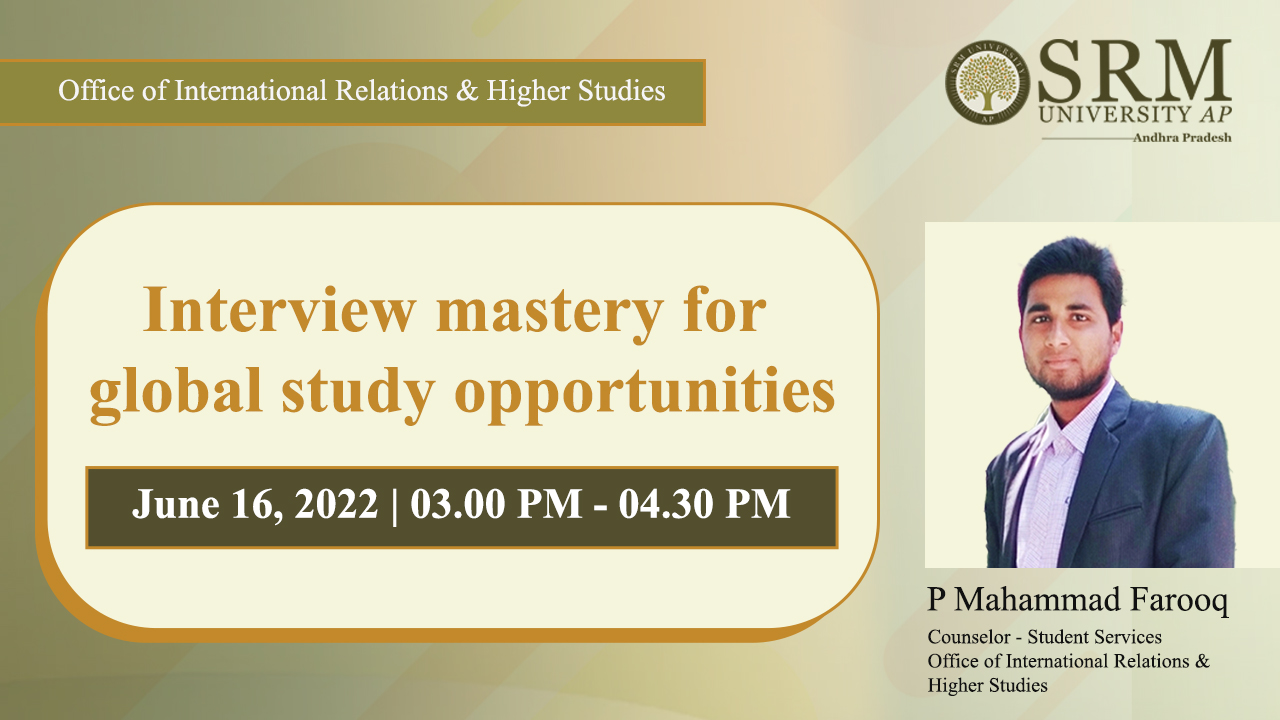 As you are aware, applying for international education can be daunting. Mastery of interview fundamentals is required to grab global study opportunities. Mr P Mahammad Farooq, Counselor- Student Services, Office of International Relations & Higher Studies, SRM University-AP, is conducting a session on the topic Interview Mastery For Global Study Opportunities on June 16, 2022, at 3.00 pm.
As you are aware, applying for international education can be daunting. Mastery of interview fundamentals is required to grab global study opportunities. Mr P Mahammad Farooq, Counselor- Student Services, Office of International Relations & Higher Studies, SRM University-AP, is conducting a session on the topic Interview Mastery For Global Study Opportunities on June 16, 2022, at 3.00 pm.
The session aims to train students to respond to the interview questions, understand difficult interviewer personalities and showcase confidence that differentiates them from other candidates.
Avail this opportunity to sketch your study abroad pathway with the Office of International Relations and Higher Studies at SRM University-AP! Join the session on June 16, 2022, at 3.00 pm.
About the speaker
P.Md. Farooq is a well-known academician with more than five years of teaching, training research in the educational industry, and administrative experience. Before joining SRM University-AP, he was a freelance trainer for soft skills, career guidance coaching, advanced spoken English and employability skills. He expanded his academic boundaries by working at training institutions like the “Global talent track Pvt Ltd-Mumbai”, seventh sense solutions-Bangalore, Pygmalion Skills solutions Pvt Ltd-Bangalore, Rubicon Skill Development Pvt Ltd-Pune etc.
- Published in Events, International Relations, IR-Events
Neodymium-doped bismuth ferrite thin films for random access memory applications
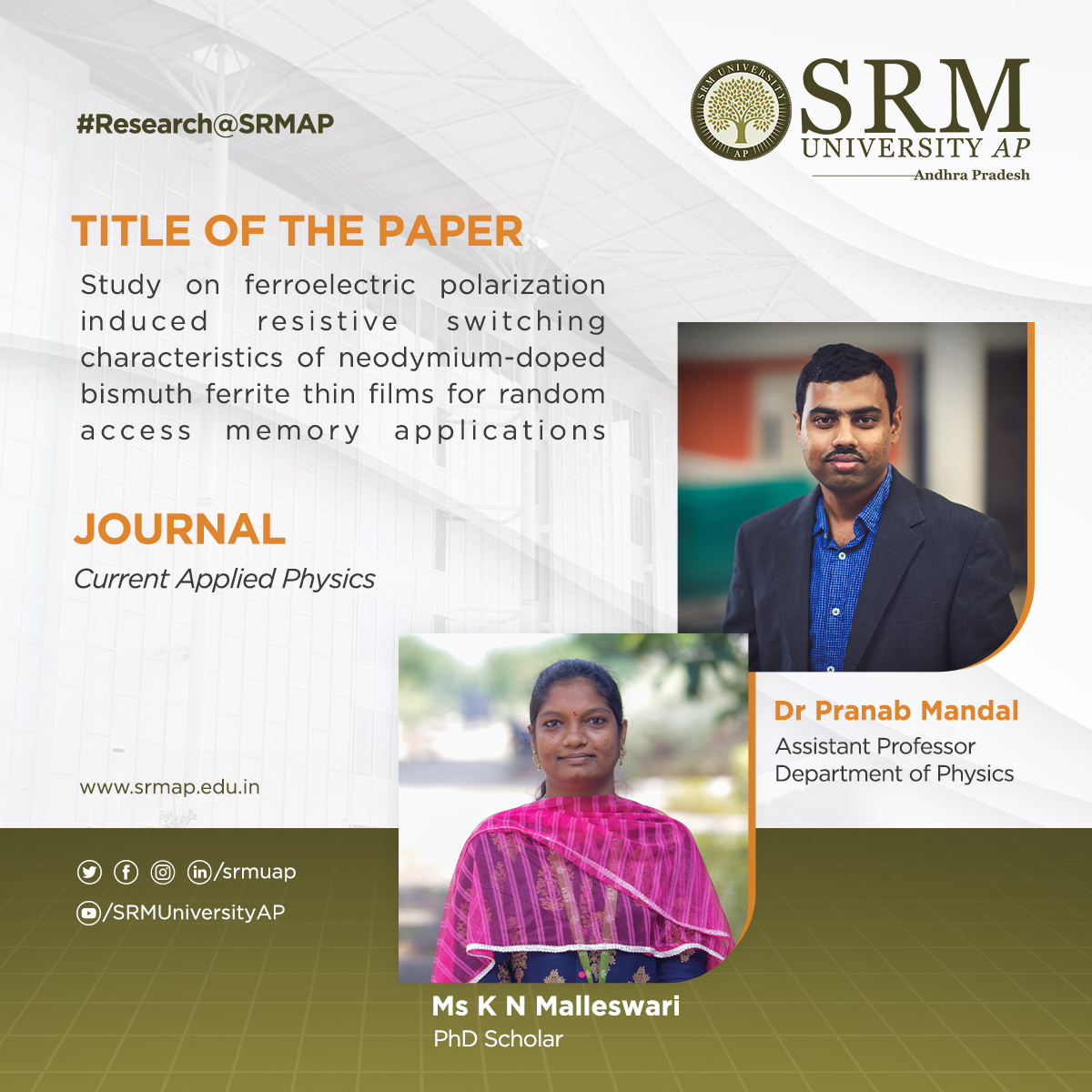 A paper titled “Study on ferroelectric polarization induced resistive switching characteristics of neodymium-doped bismuth ferrite thin films for random access memory applications” has been published by Dr Pranab Mandal, Assistant Professor of Physics and his PhD student, Ms K N Malleswari in the journal ‘Current Applied Physics’ having an Impact Factor of 2.480.
A paper titled “Study on ferroelectric polarization induced resistive switching characteristics of neodymium-doped bismuth ferrite thin films for random access memory applications” has been published by Dr Pranab Mandal, Assistant Professor of Physics and his PhD student, Ms K N Malleswari in the journal ‘Current Applied Physics’ having an Impact Factor of 2.480.
Doi: https://doi.org/10.1016/j.cap.2022.04.013
Abstract
Resistive random-access memory (ReRAM) devices are based on the resistance switching (RS) effect. Such RS devices have recently attracted significant attention due to their potential application in realizing the next-generation non-volatile memory (NVM) devices. The present work reports on resistive switching (RS) characteristics of Neodymium (Nd)-doped bismuth ferrite (BFO) layers. The Nd (2–10 at%) doped BFO thin film layers were deposited using a spray pyrolysis method. The structural analysis reveals that a higher Nd doping concentration in BFO leads to significant distortion of the prepared Nd: BFO thin films from rhombohedral to tetragonal characteristics. The morphological analysis shows that all the deposited Nd: BFO thin films have regularly arranged grains. The X-ray photoelectron spectroscopy (XPS) analysis reveals that the prepared Nd: BFO thin films have a higher Fe3+/Fe2+ ratio and fewer oxygen vacancy (VO) defects which enrich the ferroelectric characteristics in Nd: BFO layers. The polarization-electric field (P-E) and RS characteristics of the fabricated Nd: BFO-based RS device were examined. It was observed that the Nd (7 at%) doped BFO RS device shows large remnant polarization (P r) of 0.21 μC/cm2 and stable RS characteristics.
Research in brief
Non-volatile resistive random access memory (RRAM) are future generation random access memory device with potential benefits such as high operational speed (nanoseconds read and write time), non-volatility, high endurance scalability and low power consumption [Namnoscale Research Lett., 15, 90, 2020]. Here in this work, we presented the resistive switching characteristics of a multiferroic material namely Nd-doped BiFeO3 material. The device shows stable resistive switching characteristics.
Practical implementation/social implications
Researchers in this field are focusing to overcome challenges of high operation current, lower resistance ratios, and reliability issues [Namnoscale Research Lett., 15, 90, 2020]. While several prototype RRAMs have been developed by other groups, future memory applications would require overcoming the challenges mentioned above.
Collaboration
The work has been conceptualized by Dr Amiruddin at Crescent Institute of Science and Technology, Chennai; and Dr Pranab Mandal and Ms Malleswari provided inputs on ferroelectric polarization – electric field (P – E) measurement and drafting.
- Published in Departmental News, Physics News, Research News
We make a life by what we give

Miracles do happen if we are willing to believe in the power of giving. The World Blood Donor Day 2022 calls attention to the significance of voluntary blood donations in saving lives and enhancing solidarity within communities. The day aims to spread gratitude toward blood donors worldwide and create a broader understanding of the need for regular, unpaid blood donation. The day is an opportunity to highlight the urgency of committed and year-round blood donation to ensure adequate resources and achieve universal access.
This World Blood Donor Day, the Department of Student Affairs, in collaboration with Indian Red Cross Society and STEP, Swasakthi, Guntur celebrates the value of voluntary blood donations in improving social cohesion. Smt Vidadala Rajani, Hon’ble Minister for Health and Family Welfare, Andhra Pradesh, will be the chief guest of the day. She is one of the young and dynamic individuals who became an MLA in her first election and created a record as the youngest ever MLA from Chilakaluripet Constituency. Guest of Honour, Shri Alla Ramakrishna Reddy, MLA Mangalagiri, will also grace the occasion with his esteemed presence.
Date: June 14, 2022
Time: 10.30 AM IST
This World Blood Donor Day, donate blood for a reason and be the reason behind someone else’s life. Blood donation is an act of solidarity. Join the effort and save lives!
- Published in Events, Students Affairs Events
Recovery of nutrients from wastewater

Water pollution continues to be one of the serious concerns facing the country. The ensuing scenario of eutrophication and harmful algal blooms has exacerbated the menace. This demands wholescale water management techniques to segregate the pollutants, retrieve useful nutrients, and treat the water effectively for sustainable use. Dr Karthik Rajendran and his PhD scholar, Mr Sarath Chandra, from the Department of Environment Science have published a paper discussing various nutrient recovery methods and their consequential outcomes. The research was done in collaboration with Dr Deepak Kumar from SUNY College of Environmental Science and Forestry, Syracuse, NY and Dr Richen Lin from Southeast University, Nanjing, China.
The article titled, “Nutrient recovery from wastewater in India: A perspective from mass and energy balance for a sustainable circular economy” was published in Bioresource Technology Reports (Q1 Journal), having an Impact Factor of 4.41. Their research investigates the possibilities of recovering Nitrogen (N) and Phosphorous (P) from wastewater in terms of technology, energy, and economic point of view. Excessive presence of Nitrogen and Phosphorous can result in eutrophication and algal blooming. These nutrients also pose a harmful threat to infrastructure. Nutrient recovery can mitigate these challenges and improve the quality of water.
Phosphorus is one of the limited resources available on earth and a key ingredient in fertilizer production. The recovery process also helps in transforming wastewater into resource pools that can efficiently churn out valuables that hold the key to a sustainable future. This will help reduce the imports of fertilizers and bring down the emissions to half in producing fertilizers. Their findings will also pave the way for making necessary policies to reduce water pollution and recover nutrients. As two-thirds of wastewater remains uncollected, they claim that effective treatment and water management practices can save around 800 crores per annum. Their future research plan also includes the experimental analysis of the nutrient recovery system.
Abstract of the Research
Wastewater (WW) is a potential source to recover N, and P, whereas, in India, it is scarcely explored. In this work, four different nutrient recovery methods were compared from a mass- and energy-balance perspective to understand the overall process flow. From 1000-m3 WW, chemical precipitation yielded 33.8 kg struvite, while micro-algae resulted in 299.1 kg (dry powder). Energy consumption was lowest for the fuel cells at 216.2 kWh/1000 m3, while microalgae used the highest energy at 943.3 kWh/1000 m3. Nonetheless, the cost-saving analysis showed that microalgae (78.6$/1000 m3) as a nutrient recovery choice, had higher savings than any other methods compared. For a country like India, where two-thirds of urban wastewater is untreated, wastewater-biorefinery options such as nutrient recovery hold the key to a sustainable circular economy.
- Published in Departmental News, ENVS News, News, Research News
Enhanced charge transport behaviour of protein-metal nanocluster hybrid

Proteins are the most vital life forms which maintain close coordination with almost living activities through their biological functions. Nevertheless, in most cases, proteins suffer from low charge (electron) transfer efficiency as they are mainly made of insulating organic molecules. The interdisciplinary research publication, of Dr Sabyasachi Mukhopadhyay and Dr Sabyasachi Chakrabortty from the Department of Physics & Department of Chemistry respectively, along with their PhD scholars: Ms Ashwini Nawade, Mr Kumar Babu Busi and Ms Kunchanapalli Ramya, envisions the molecular-level understanding of the charge transport behaviour of various protein-metal nanocluster hybrid.
The article titled ‘“Improved Charge Transport across Bovine Serum Albumin – Au Nanoclusters’ Hybrid Molecular Junction” was featured in the prestigious Q1 journal ACS Omega (IF: 3.512), published by the ‘American Chemical Society’. They successfully incorporated Gold Nanoclusters inside the protein backbone leading to an increase in their conductivity. This will provide new avenues for the rational design of bioelectronic devices with optimized features. The BSA-Au cluster has been a promising model for bioelectronic functionalities. With an increase in their current carrying capacity, they can be used for many more applications, especially as the interface between tissue and organ in biocompatible devices. The research team is also planning to work with various protein dopants to understand their charge transport mechanism. These studies will help in using the protein for various applications mainly in bioimplants or biosensors for drug testing and diagnostics purposes.
Abstract of the Research
Proteins, a highly complex substance, have been the essential element in the living organism where various applications are envisioned due to their biocompatible nature. Apart from protein’s biological functions, contemporary research mainly focuses on their evolving potential associated with nanoscale electronics. Here, we report one type of chemical doping process in model protein molecules (BSA) to modulate its electrical conductivity by incorporating metal (Gold) nanoclusters on the surface or within it. The as-synthesized Au NCs incorporated inside the BSA (Au 1 to Au 6) were optically well characterized with UV-Vis, time-resolved photoluminescence (TRPL), X-ray photon spectroscopy, and high-resolution transmission electron microscopy techniques. The PL quantum yield for Au 1 is 6.8% whereas Au 6 is 0.03%. In addition, the electrical measurements showed ~10-fold enhancement of conductivity in Au 6 where maximum loading of Au NCs was predicted inside the protein matrix. We observed a dynamic behaviour in the electrical conduction of such protein-nanocluster films, which could have real-time applications in preparing biocompatible electronic devices.
- Published in Chemistry-news, Departmental News, News, Physics News, Research News
Hon’ble Minister Smt Vidadala Rajini inaugurates SRM AP blood donation camp
Organised in association with the Indian Red Cross Society and STEP Swasakthi Guntur
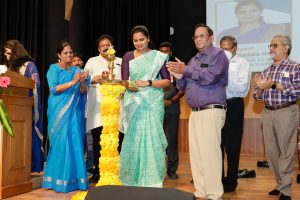 Around 140 students, faculty, non-teaching staff, and administrative members of SRM University-AP participated in the blood donation camp organised as a part of World Blood Donor Day. “You are really fortunate to be a part of this world-class university”, said Chief Guest Ms Rajini Vidadala, Hon’ble Minister for Health & Family Welfare-Government of Andhra Pradesh. She also acknowledged the CSR initiatives and commitment toward social causes by SRM Medical College and Research and the SRM group of institutions.
Around 140 students, faculty, non-teaching staff, and administrative members of SRM University-AP participated in the blood donation camp organised as a part of World Blood Donor Day. “You are really fortunate to be a part of this world-class university”, said Chief Guest Ms Rajini Vidadala, Hon’ble Minister for Health & Family Welfare-Government of Andhra Pradesh. She also acknowledged the CSR initiatives and commitment toward social causes by SRM Medical College and Research and the SRM group of institutions.
In his presidential address, Pro-Vice-Chancellor Prof D Narayana Rao talked about the virtue of regular, voluntary, and unpaid blood donations. He further highlighted SRM University-AP’s achievements in building next-generation world-class scientists and innovators. He narrated the university’s commitment to creating a conducive research ecosystem.
World Blood Donor Day is observed on June 14 every year around the world to promote awareness about the need for safe transfusion and honour blood donors for their selfless act of saving lives. This year WHO observes the day on the theme “Donating blood is an act of solidarity. Join the effort and save lives”.
“This is the fourth time I am donating blood from SRM AP. I feel so proud and happy to be a part of this noble deed,”- says Ms Shalini Jayakumar, Assistant manager- Office of Examinations. She also encouraged women to come forward and donate blood without the fear of after-effects.
Certificates were distributed to the benevolent blood donors of SRM University-AP. Prof D Narayana Rao felicitated the Hon’ble Minister with a memento for her prolific contributions to society. The blood donation camp was organised in association with the Indian Red Cross Society (IRCS) and STEP Swasakthi Guntur. Addressing the gathering, Ramachandra Raju- Vice Chairman, IRCS Guntur, appreciated the non-teaching staff for being the leading light to students. NSS Coordinator of the university, Dr Lakshman Rao and Programme Officer Dr Pardha Saradhi Maram highlighted the role of blood donation in saving lives.
Dr R Premkumar-Registrar, Ms Suma N- Chief Finance and Accounts Officer (CFAO), Ms Revathi Balakrishnan- Student Affairs Assistant Director, Deans and Associate Deans of various schools, and Directors and Associate Directors of different departments were present at the meeting held at the university auditorium.
- Published in News, student affairs news
Mr Aaditya Jain’s article featured in Brainz magazine
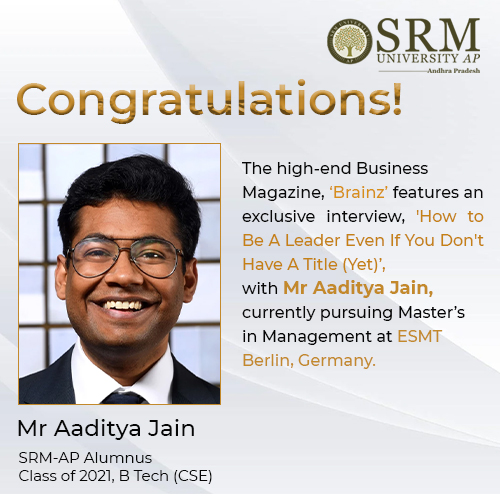
The leaders of tomorrow are defined by the clarity of thought in translating their vision into action. Their words reflect the undying spirit to make it big in life and brace up the world for unforeseen challenges in the times to come. Currently pursuing Master’s in Management at ESMT Berlin, Mr Aaditya Jain, the alumnus of Class of 2021, Computer Science and Engineering, is one such promising leader who is on an endeavour to gear up his personal and professional limits with a solid vision and impeccable work ethic. The high-end Business magazine of Europe, ‘Brainz’ has recently featured his article titled ‘How to Be A Leader Even If You Don’t Have A Title (Yet)’.
Brainz magazine is a global digital periodical that brings influential entrepreneurs, coaches, and business experts to share their knowledge and stories with the world. It features articles across various themes- exploring business innovations, leadership mindsets, aspirational lifestyles, and many more. The magazine aims to disperse inspiring content to augment the quality of life in all aspects. In an interview with Snježana “Ana” Billian, Aaditya shared the top four tips on how to show leadership at work, even if you don’t have a leadership title. As far as he is concerned, one must lead oneself before venturing out to lead others.
Aaditya pronounces the importance of self-awareness as it gives the opportunity to capitalize on one’s strengths and weaknesses to create as much value as possible in every situation. “One of the most powerful things I was told by one of my professors back during my undergrad is: We have all the resources within us. This statement inspired me to embark on a journey of self-discovery” he remarked. Aaditya is also aware of the huge benefit of the internet. Sharing one’s views and experiences online does not require a title. He regularly shares his experience at work and the lessons he learned on leadership online. This makes it easier for him to reach out to like-minded people and create a shared value.
“The need to mould oneself as a proactive communicator and concoct a support network at professional space is essential to ensure one’s career advancement”, says Aaditya. He believes, that asking out for help is a quality that must be encouraged. He further went on to divulge how moving to Germany and settling in was not an easy job. But according to him, the greatest challenge was how to make the most out of it. Success in the words of Aaditya is, “Living my values while continuously growing and inspiring human leadership at work”.
Here is the link to his article: https://www.brainzmagazine.com/post/how-to-be-a-leader-even-if-you-don-t-have-a-title-yet
- Published in Alumni Relations News, CSE NEWS, Departmental News, News, Students Achievements

